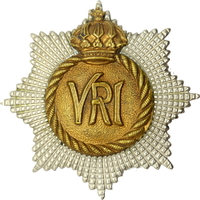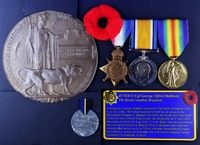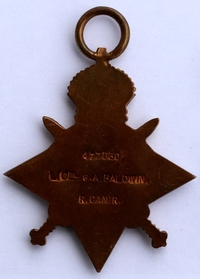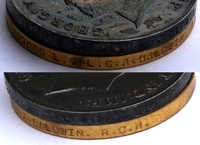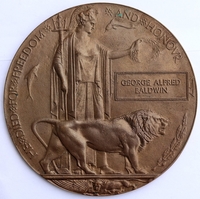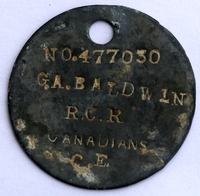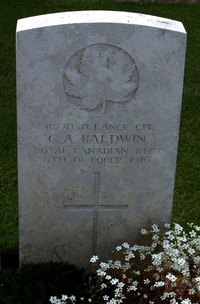
9750 / 477030 L/Cpl George A. Baldwin
The Devonshire Regiment
The Royal Canadian Regiment
By: Capt (ret'd) Michael M. O'Leary, CD, The RCR
George Alfred Baldwin was born in London, England, on 15 Dec 1883. He enlisted in the Devonshire Regiment of the British Army on 3 Aug 1901, serving in the regiment for 12 years. There is no indication of where he served with the Devons in his C.E.F. service record. He likely reached the 1st Battalion of the regiment, which left South Africa in Jan 1902 (probably too late for Baldwin to see service there). From there the unit went to Rhaniket in India, then to Chaubatta in 1904, Rangoon, Burma, in 1905, Tidworth, England, in 1908, and then to Jersey in 1911. Baldwin was discharged on 2 Aug 1913 with good character.
Emigrating to Canada after his discharge from the British Army, Baldwin enlisted in the Canadian Permanent Force with The Royal Canadian Regiment on 13 Nov 1913 at Halifax, N.S.. Identifying his trade as "Musician," Baldwin was given the regimental number 9750.
Baldwin's pre-war documents in his service record note a period of hospitalization of 12 days from 27 Jan to 7 Feb 1914. The cause for his time in hospital is given as "abrasion, fingers" but no details of how he received the injury was recorded.
After almost a year in The RCR, Baldwin's prior experience as a Regular Army soldier is rewarded on 3 Oct 1914 when he is appointed Lance Corporal, without pay. Unfortunately, this wouldn't last as he was deprived of his Lance Corporal stripe on 18 Oct 1914, for drunkenness. A few months later he was in trouble again, on 1 Feb 1915 Baldwin received the punishment of 8 days Confinement to Barracks ("C.B."), again for drunkenness.
Baldwin is listed on the nominal roll for The RCR in Bermuda. On 11 Sep 1914, The Royal Canadian Regiment sailed for Bermuda where they would serve for a year on garrison duty. On arriving in Bermuda, the Regiment relieved the 2nd Battalion, Lincolnshire Regiment, which sailed immediately for England. The Regiment was replaced in turn by the 38th Canadian Infantry Battalion and then returned to Halifax to reattest for overseas service with the Canadian Expeditionary Force.
While serving in Bermuda, Baldwin received anti-typhoid inoculations. These were administered on 15 and 27 Jul 1915, a few months before the Regiment left the island. He also received a new opportunity to prove himself ready for greater responsibility. On 22 Jul 1915, he was appointed Acting Lance Corporal.
In August 1915, The RCR was relieved in Bermuda by the 38th Canadian Infantry Battalion, which arrived aboard the S.S. Caledonian on August 12. On the following day The RCR embarked on the Caledonian and sailed for Halifax.
Back in Halifax with the Regiment, Baldwin signed his C.E.F. attestation form at Halifax on 23 Aug 1915. In the brief time between returning to Halifax from Bermuda and sailing for England on the same troopship, The RCR re-attested all soldiers because their Permanent Force enlistments were not considered sufficient for wartime service in Europe. A musician, Baldwin was on his attestation paper described as 5 feet 5 1/4 inches in height, with a 41-inch chest, a fresh complexion, brown eyes, and dark brown hair. His medical history form notes a weight of 132 pounds and good physical development with slight varicose veins that were not judged to be grounds to cause rejection. His records identify tattoo marks on both forearms and chest, including the "head and bust of the late King Edward, surrounded by flags" on his chest. Baldwin identified his sister as his next of kin; Mrs. A. Whealen of Shepney, London, England (address later changed to 60 Bridge St., Burdett Road, Mile End E., London, Eng.). Baldwin's religious affiliation was Church of England.
On 26 Aug 1915, The RCR sailed once more aboard the Caledonian. Disembarked at Plymouth, Engl., on 6 Sep 1915, the Regiment went to Shorncliffe for training. While The RCR was training in England, the Regiment was given a new block of C.E.F. service numbers to replace the soldiers' regimental numbers. Accordingly, the unit was renumbered in alphabetical order, and George Baldwin was given the service number 477030 on 28 Sep 1915.
Baldwin's appointment as Lance Corporal was confirmed on 4 Oct 1915 while the Regiment was training in England. Soon after, as part of the preparations to go to France, George Baldwin completed a military Form of Will on 13 Oct 1915, while the Regiment was at Quested Farm, Shorncliffe. He identified that all of his estate would be bequeathed to his sister Mrs. A. Whelan, at Stepney Union, Bromley-By-Bow. The witnesses to this will were Lieut. Vernon Hodson and Gordon Hymmen (soldier).
The RCR entered France on 1 Nov 1915, disembarking at Boulogne. Following a period of introductory training where companies of the Regiment conducted front line trench tours with Battalions of the 1st Canadian Division, the Regiment was employed on working parties from mid-November to mid-December, 1915, and went into Corps Reserve on 19 Dec 1915.
After the Regiment's introduction to trench warfare, the winter was spent rotating between the front line, support trenches and reserve positions. About one-third of the time would be spent in front line trenches, usually in four day rotations. The summer campaigns of 1916 would begin with the battles at "Mount Sorrel" in the first half of June, "Somme, 1916" extending from July to November with the additional battle honour actions at "Flers-Courcelette" and "Ancre Heights".
George Baldwin would receive a "G.S.W.," (i.e., a gun shot wound, which could be either by bullet, shrapnel ball, or shell splinter) in the thigh during a front line tour in the Ypres area in August, 1916. His service record contains no specific details of the wound, and notes that he was admitted to No. 8 Stationary Hospital, Wimereux, on 17 Aug 1916. With over 100 kilometres separating the trenches near Ypres and the hospital at Wimereux, Baldwin may have been wounded a day or two earlier. The Regiment's War Diary notes that some soldiers were wounded during the preceding days after going into the line of the night of 12/13 August.
After being treated at Wimereux, Baldwin was transferred to No. 1 Convalescent Depot, Boulogne, on 19 Aug 1916. He did not remain here long, being discharged from hospital to Base Details on 29 Aug 1916. A month later, on 28 Sep 1916, he joined the 3rd Entrenching Battalion in the field on 28 Sep 1916. The entrenching battalions were forward holding units which held a ready supply of reinforcements for the division's fighting battalions. They were also used as labour forces to maintain and build trenches or other work as needed. Baldwin did not stay long, and was back with the Regiment by early October, 1916.
It was on 8 Oct 1916 that George Baldwin would fall in battle. The names "Somme," "Ancre Heights," and "Regina Trench" are all applicable names for the action where he fell in battle. The Regiment's "Battle Bar Document" (prepared after the war by the Militia Department in anticipation of the possibility of clasps for the British War Medal) provides the following details for 8 Oct 1916:
"8 Oct 1916 –
"4.30 a.m. – Bn in "jumping off" position.
"4.50 a.m. – Bn advanced to the attack on REGINA TRENCH taking objective and many prisoners. The objective was held for four hours, during which time 3 counter-attacks were repulsed. Owing to Bn on Left having failed to reach their objective Bn was compelled to withdraw in order to avoid being outflanked."
The War Diary of The RCR relates a day of severe fighting on 8 Oct 1916 as the battle raged for Regina Trench. The narrative of the battle states only 140 effective members of the battalion marched from the battlefield, the remainder having been evacuated wounded, or buried. The following day's War Diary entry summarizes the cost:
9-10-16. – TRENCHES. – "Cloudy, not quite so cool. See Appendix No. 4. Total casualties reported to date are Captain SAPTE, Lieuts. SIMPSON, WALSH, SUTTON and PENNIMAN, Missing 8-10-16. Major HODSON, Major WOOD, Lieuts. DICKSON, DWYER, BELL and MURRAY, WOUNDED 8-10-16. Killed 7 other ranks. Missing 207 other ranks. Wounded 68 other ranks. It is expected that most of those reported missing will be located through slips from Casualty Clearing Stations as having passed through dressing stations of other regiments on our flanks."
Lance Corporal George Alfred Baldwin was reported "Missing after Action" on 8 Oct 1916.
In 1917, a Priest provided assistance to Baldwin's sister, hoping to clear up some confusion over the identification of his next of kin:
"Re. Abigail Maria Whelan Nee Baldwin
"I beg to state that the deceased soldiers G.A. Baldwin by a mistake made out his will to Mrs Baldwin instead of Mrs. A.M. Whelan. A.M. Whelan was married in my presence to Mr. T. Whelan – some six years ago; & though the testator knew this (as may be gathered by the addresses on enclosed envelope) – he nevertheless made the mistake referred to.
"(Signed) Rev. A. Donlin
Catholic Presbytery
48 Bow Rd., London, E.
21/2/17.
"Copy of a letter written by:–
No. 477030 – L/Cpl G.S. Baldwin – R.C.R. enclosed in an envelope addressed to:–
Mrs A. Whealan, Stepney Union, Bromley-on-Bow, London, E.
"A" Company R.C.R.
"Shorncliffe. Kent.
"My Dear Sister
"A few lines to you hoping you are well, as I am pleased to say I am the same at present, I must say we are having some awful weather here, & as we are under canvas it is very hard to get through its nothing but rain & cold, & makes it like a quagmire all puddles & mud, never mind I suppose we will get over it some day. I cannot tell you when we will go over the other side, but it must be very soon, how do you think the war is going on, terrible I suppose don't you, you must excuse me for not writing before as we have been very busy of later, & we could not call the time our own, remember me to all who may recollect me, hope they are all well, I must say they are very sparing with leave here, as I have had only one week end to see you, & can't get any more, never mind I can only hope to come back safe, so as I can see you all. I would like to have heard what the trouble was, you mentioned in your last letter before I went to the front, so buck up & let me know before I go, I have left you in my Will so you must look out for the papers & watch for me in the list, so as you can claim if anything goes wrong. I must close now with fondest & best Love to you,
"From your Affect Brother.
477030 LCpl G.A. Baldwin"
On 14 Jun 1917, an Army Form B. 2090c., titled "Missing Man (Acceptance of Death for Official Purposes)", was completed with reference to Baldwin's death. This form confirmed that Baldwin had been missing since 8 Oct 1916 and that "Reference has been made to the Unit, the Record Office and the base, on the printed missing list, but no evidence of material value has been received which would indicate that he is not dead." The form continued with the determination that "In accordance with the decision of the Army Council, this soldier is to be regarded for official purposes as having died on or since the above date" and a call was put to the recipients of the form for any available copy of a will. The section seeking a will was stamped "Not Received."
Baldwin's service record includes a notation dated 31 Oct 1917 that the Records Office received the confirmation that Baldwin was then considered to be "Now reported Killed in Action." As a result, on 6 Nov 1917, Baldwin' status as a casualty was changed from "Previously reported missing, presumed dead" to "Killed in Action."
Baldwin was originally buried near where he fell, in a temporary grave "near Courcelette, 5 1/2 miles North East of Albert." In 1920, in the relocation of graves to established Commonwealth War Graves Commission cemeteries, his body was exhumed and moved to Regina Trench Cemetery, Grandcourt, France (Plot 1, Row D, Grave 20). He is one of 50 Royal Canadians buried in this cemetery.
For his Great War service, George Baldwin was entitled to receive the 1914-15 Star, the British War Medal and the Victory Medal. These were despatched to his sister in March and August of 1921. Baldwin's next of kin also received a Memorial Scroll sent to them on 9 Apr 1921 and the Memorial Plaque despatched 12 Jul 1922. No Memorial Cross was issued to the family because Baldwin was unmarried and his mother had predeceased him.
Pro Patria
Visit a randomly selected page in The O'Leary Collection (or reload for another choice):
- The O'Leary Collection; Medals of The Royal Canadian Regiment.
- Researching Canadian Soldiers of the First World War
- Researching The Royal Canadian Regiment
- The RCR in the First World War
- Badges of The RCR
- The Senior Subaltern
- The Minute Book (blog)
- Rogue Papers
- Tactical Primers
- The Regimental Library
- Battle Honours
- Perpetuation of the CEF
- A Miscellany
- Quotes
- The Frontenac Times
- Site Map
QUICK LINKS
The O'Leary Collection—Medals of The Royal Canadian Regiment
Newest additions:
![]()
![]() SB-12725 Private Henry "Hank" Ard
SB-12725 Private Henry "Hank" Ard ![]()
WIA at Hill 187, Died of Wounds in Japan
![]()
![]() 2355331 Lance Corporal Albert Lorking
2355331 Lance Corporal Albert Lorking
Wounded in action, later a War Amps representative.
![]()
![]() 4334 / 477996 Pte Isaac Hamilton Wilcox
4334 / 477996 Pte Isaac Hamilton Wilcox
Permanent Force, South Africa, and C.E.F.
![]()
![]() 477019 Private Harold Ashcroft
477019 Private Harold Ashcroft
Transferred to the Tunnelers.
![]()
![]() 734231 Private Clark D. Thompson
734231 Private Clark D. Thompson ![]()
The older Thompson brother, killed in action.
![]()
![]() 733849 Private Norman Parker Thompson
733849 Private Norman Parker Thompson
The younger Thompson brother; post-war service in the Special Guard.
![]()
![]()
![]() A305 / 400305 Private Andrew Walker
A305 / 400305 Private Andrew Walker ![]()
"Previously reported Wounded, now Killed in Action."
![]()
![]() 823298 Pte Thomas Patrick Steele, M.M.
823298 Pte Thomas Patrick Steele, M.M. ![]()
… for gallant conduct in the field …
![]()
![]() P13066 Sergeant Harold Thompson
P13066 Sergeant Harold Thompson
Instrumental Soloist for over 20 years of Canadian Army service.
![]()
![]() 9609 / 477728 Private Albert Edward Piper
9609 / 477728 Private Albert Edward Piper
"Arrived from England as a STOWAWAY …"
